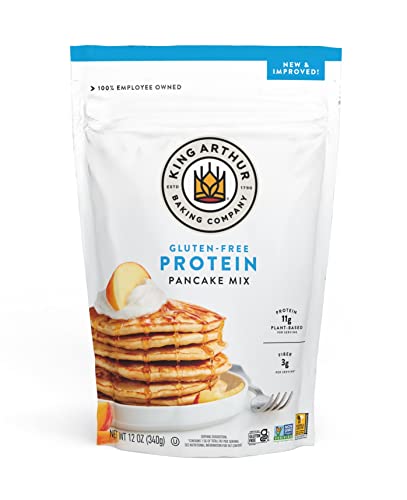Gluten free diets have become increasingly popular in recent years, and for good reason. For those with celiac disease, a gluten free diet is a necessity to avoid serious health complications. However, many people are now choosing to go gluten free even if they do not have a gluten intolerance. There are several benefits to going gluten free, including improved digestion and increased energy levels. By eliminating gluten from your diet, you may find that you experience less bloating, gas, and stomach discomfort after meals.
King Arthur Gluten Free Protein Pancake Mix, 12 Oz
Indulge in delicious gluten free protein pancakes with King Arthur's 12 Oz mix
Product information
SGD 16.28
Product Review Score
4.63 out of 5 stars
214 reviewsProduct links
Another benefit of going gluten free is the potential weight loss that can accompany the change in diet. Many gluten containing foods are high in carbohydrates and can contribute to weight gain. By cutting out gluten, you may find that you naturally eat fewer processed foods and consume more whole, nutrient-dense foods instead. This can lead to a healthier overall diet and may help you reach your weight loss goals.
In addition to improved digestion and potential weight loss, going gluten free can also have a positive impact on your skin. Some people find that eliminating gluten from their diet can help reduce skin irritations such as acne or eczema. The inflammation that gluten can cause in the body may manifest in the skin, so cutting it out could lead to clearer, healthier skin. Overall, making the switch to a gluten free diet can have numerous benefits for your health and well-being.
Choosing the Right Gluten Free Flour
When it comes to baking gluten free bread, choosing the right flour is key to achieving the perfect texture and flavor. With so many options available, it can be overwhelming to know which one to use. Here are some of the most popular gluten free flours and their characteristics to help guide you in selecting the best one for your bread recipe.
1. Almond Flour:
Almond flour is made from finely ground almonds and adds a nutty flavor to baked goods. It is high in protein and healthy fats, making it a nutritious choice for gluten free bread. However, almond flour is not ideal for bread recipes that require a lot of rise, as it can be quite dense.
2. Rice Flour:
Rice flour is a versatile option that can be used alone or mixed with other gluten free flours. It has a neutral flavor and creates a light, tender texture in baked goods. Rice flour is a good choice for bread recipes that require a fine crumb structure.
3. Sorghum Flour:
Sorghum flour is a whole grain flour that adds a slightly sweet flavor to bread. It is high in fiber and protein, making it a nutritious choice for gluten free baking. Sorghum flour works well in recipes that call for a chewy texture, such as sandwich breads.
4. Coconut Flour:
Coconut flour is a unique option that is highly absorbent and requires more liquid than other flours. It has a subtle coconut flavor and adds a hint of sweetness to baked goods. Coconut flour is best used in combination with other gluten free flours to prevent a dry or crumbly texture in bread.
Easy Gluten Free Bread Recipes
Looking for delicious gluten free bread recipes that are easy to make at home? Look no further! Here are a few simple recipes that will satisfy your bread cravings without the gluten.
1. Gluten Free Banana Bread: This moist and flavorful banana bread is a great way to use up ripe bananas. Simply substitute gluten free flour for the regular flour in your favorite banana bread recipe, and you'll have a tasty gluten free treat in no time.
Banana bread is a classic comfort food that is loved by many. However, for those who have a gluten intolerance or celiac disease, enjoying this delicious treat can be a challenge. Luckily, there are many gluten-free alternatives that can satisfy your cravings for banana bread. In this blog post, we will share with you a simple and delicious gluten-free banana bread recipe that you can easily make at home.
2. Gluten Free Garlic Herb Bread: This savory bread is perfect for dipping in soups or serving alongside your favorite pasta dish. Just mix gluten free flour with garlic, herbs, and a bit of olive oil, then bake until golden brown for a delicious and fragrant treat.
3. Gluten Free Pumpkin Bread: Embrace the flavors of fall with this delicious gluten free pumpkin bread. Simply mix canned pumpkin puree with gluten free flour, pumpkin pie spice, and a touch of maple syrup for a moist and sweet treat that's perfect for breakfast or dessert.
Tips for Baking Perfect Gluten Free Bread
When baking gluten free bread, the key is to use the right flour blend. Look for a gluten free flour blend that is specifically designed for baking bread, as it will have the right balance of ingredients to help your bread rise and have a nice texture.
2. Add Xanthan Gum:
Xanthan gum is a common ingredient in gluten free baking, as it helps to bind the ingredients together and give the bread a better structure. Add a teaspoon or two of xanthan gum to your flour blend to help your bread rise and hold together better.
3. Don't Overmix:
When mixing the ingredients for your gluten free bread, be careful not to overmix. Overmixing can cause the bread to become dense and gummy. Mix the ingredients until they are just combined, then stop to ensure a light and airy texture.
4. Let it Rise:
Gluten free bread often takes longer to rise than traditional bread, so be patient. Let your bread rise in a warm, draft-free place for the recommended amount of time to ensure a good rise and a light and fluffy texture.

